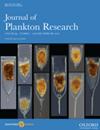Under ice plankton and lipid dynamics in a subarctic lake
IF 2
3区 环境科学与生态学
Q2 MARINE & FRESHWATER BIOLOGY
引用次数: 0
Abstract
Climate warming causes shorter winters and changes in ice and snow cover in subarctic lakes, highlighting the need to better understand under-ice ecosystem functioning. The plankton community in a subarctic, oligotrophic lake was studied throughout the ice-covered season, focusing on lipid dynamics and life history traits in two actively overwintering copepods, Cyclops scutifer and Eudiaptomus graciloides. Whereas C. scutifer was overwintering in C-IV to C-V stage, E. graciloides reproduced under ice cover. Both species had accumulated lipids prior to ice-on and showed a substantial decrease in total lipid content throughout the ice-covered period: E. graciloides (60%–38% dw) and C. scutifer (73%–33% dw). Polyunsaturated fatty acids of algal origin were highest in E. graciloides and declined strongly in both species. Stearidonic acid (18:4n-3) content in E. graciloides was particularly high and decreased rapidly during the study period by 50%, probably due to reproduction. The copepods differed in feeding behavior, with the omnivore C. scutifer continuing to accumulate lipids until January, whereas the herbivorous E. graciloides accumulated lipids from under-ice primary production during the last months of ice-cover. Our findings emphasize the importance of lipid accumulation and utilization for actively overwintering copepods irrespective of the timing of their reproduction.一个亚北极湖泊的冰下浮游生物和脂质动力学
气候变暖导致亚北极湖泊的冬季缩短,冰雪覆盖面积发生变化,这突出表明有必要更好地了解冰下生态系统的功能。研究人员对一个亚北极低营养湖泊在整个冰封季节的浮游生物群落进行了研究,重点是两种积极越冬的桡足类--Cyclops scutifer 和 Eudiaptomus graciloides--的脂质动态和生活史特征。C. scutifer在C-IV至C-V阶段越冬,E. graciloides则在冰盖下繁殖。这两个物种在冰封前都积累了脂质,在整个冰封期间总脂质含量大幅下降:E. graciloides(60%-38%干重)和 C. scutifer(73%-33%干重)。藻源多不饱和脂肪酸在 E. graciloides 中含量最高,在这两个物种中含量都大幅下降。E. graciloides 的硬脂烷酸(18:4n-3)含量特别高,在研究期间迅速下降了 50%,这可能是由于繁殖所致。桡足类的摄食行为不同,杂食性的 C. scutifer 在一月份之前一直在积累脂质,而草食性的 E. graciloides 则在冰盖覆盖的最后几个月从冰下初级生产中积累脂质。我们的发现强调了脂质积累和利用对积极越冬的桡足类的重要性,无论其繁殖时间如何。
本文章由计算机程序翻译,如有差异,请以英文原文为准。
求助全文
约1分钟内获得全文
求助全文
来源期刊

Journal of Plankton Research
生物-海洋学
CiteScore
3.50
自引率
9.50%
发文量
65
审稿时长
1 months
期刊介绍:
Journal of Plankton Research publishes innovative papers that significantly advance the field of plankton research, and in particular, our understanding of plankton dynamics.
 求助内容:
求助内容: 应助结果提醒方式:
应助结果提醒方式:


